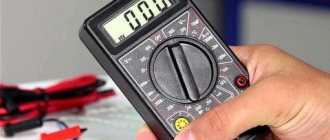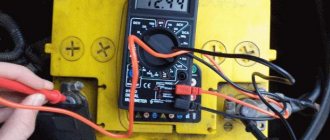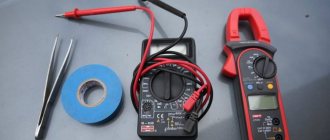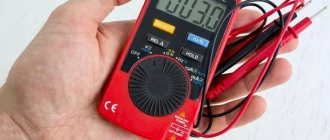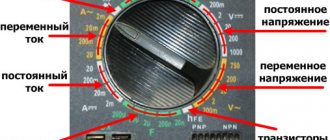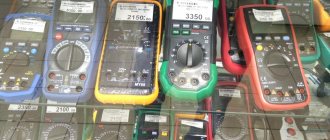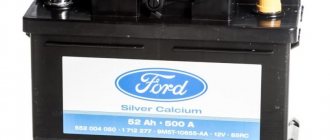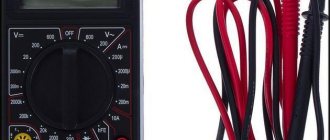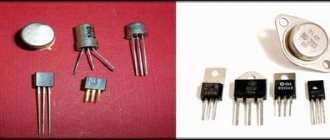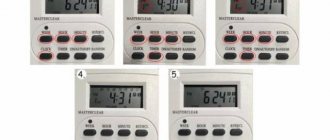A multimeter is a fairly well-known device that allows you to perform all the necessary electrical measurements in a matter of seconds. With its help, you can quickly and accurately set the current, voltage, and resistance. At the same time, it allows you to easily and most effectively test the chain for its integrity.
As numerous practice shows, with the help of a multimeter, people who work in radio engineering check diodes and transistors for their performance. If we talk about more expensive models, they have much more functions and even allow you to measure capacitance of capacitors, temperature, inductance and many other characteristics that electrical equipment may have.
How to use a multimeter dt-830b, dt-838, dt-832b, instructions for use for dummies are considered incredibly popular, because these are the models of devices that are usually used most often. They are easy to use and not very expensive. If you have no idea how to handle a measuring device of this type, then on our website you can find a large number of videos that show all the details of using the product in practice.
Meet the tester
First of all, we will briefly tell you what is on the front panel of the measuring device and what functions you can use when working with the tester, after which we will tell you how to measure resistance, current and voltage in the network. So, on the front side of the digital multimeter there are the following symbols:
- OFF – tester is turned off;
- ACV – alternating voltage;
- DCV – constant voltage;
- DCA – direct current;
- Ω - resistance;
You can clearly see the front appearance of the electronic tester in the photo:
You probably immediately noticed the 3 connectors for connecting probes? So here we need to immediately warn you that it is necessary to correctly connect the tentacles to the tester before taking measurements. The black wire is always connected to the output labeled COM. Red according to the situation: in order to check the voltage in the network, current up to 200 mA or resistance, you must use the “VΩmA” output; if you need to measure the current value above 200 mA, be sure to insert the red probe into the socket marked “10 ADC”. If you do not take this requirement into account and use the “VΩmA” connector to measure large currents, the multimeter will quickly fail because The fuse will blow!
There are also old-style devices - analog or, as they are commonly called, dial multimeters. The model with an arrow is practically no longer used, because such a scale has a higher error and, moreover, measuring voltage, resistance and current using a dial indicator is less convenient.
If you are interested in how to use a dial multimeter at home, we immediately recommend watching a visual video lesson:
We will talk in more detail later about how to use a more modern digital model of the tester, looking at step-by-step instructions in pictures.
Functions performed by the device
The word “multimeter” itself consists of two words: “multi” means “many”, and “meter” means “to measure”. It turns out that using the device you can make many different measurements. The first devices were point devices. The arrow rotated along the scale using an electromagnet, and a spring returned it back. Modern devices have mostly completely switched to digital display. What can they measure? To understand how to use the DT 838 multimeter, it is important to know its features.
Constant pressure
The presence of electric current is difficult to determine without a device. You can, of course, touch it with your hand if you know that the voltage is small, but how do you know what it is? Existing indicators only indicate the presence of life-threatening voltage. It is measured between two points and shows the potential difference if there is no external influence. The circuits in which the measurements are made are divided into two types:
- D.C.
- Alternating current.
Constant is a current whose magnitude and direction do not change over time. An example would be a battery.
Variable current is a current that changes its magnitude and (or) direction over time . This includes:
- sinusoidal;
- intermittent;
- rectified.
In practice, alternating voltage means a sinusoidal current that changes its polarity. It is also called periodic because the polarity changes regularly at regular intervals. Measuring DC voltage is not difficult, since the value remains unchanged over time.
On the panel of the DT 838 multimeter itself, in the upper left corner there is a letter V, next to which a straight and broken line is drawn. The polygon outlined in white contains numbers. This is a scale for measuring DC voltage, where the maximum values of the measured voltage are indicated. If there is a letter m next to the number, then millivolts are measured. 1 volt contains 1000 mB. To connect the required value, the marked end of the multimeter handle is aligned with the selected number.
Effective value
The DT 838 digital multimeter comes with probes with wires of different colors. Black connects to the bottom socket, red to the middle one. These sockets on the instrument panel are graphically connected, and the inscription present shows the limits of the measured current and voltage. The indicators allow you to measure direct and alternating voltage up to 600 V, and current up to 200 mA.
Alternating (sinusoidal) voltage constantly changes over time, and this presents a certain difficulty. If we take the average value, it will be equal to zero, obtained by adding the maximum “plus” with the maximum “minus”. Therefore, different measurement methods are used:
- instant;
- amplitude;
- valid.
The instantaneous value shows the voltage at a certain time, and the amplitude value determines the maximum value. These methods are rarely used, because they mainly reveal the effective voltage. To do this, compare the work of alternating and direct current, dividing the amplitude value by the root of two (approximately 1.41). Knowing the effective value, you can determine the amplitude. For example, if the network is 220 V (rms value), then the amplitude will be equal to 311 V.
Technically, this happens as follows: two diodes connected in series are connected in parallel with the same other two diodes. An alternating voltage is connected between two series-connected diodes, the positive voltage is removed from the combined cathodes, and the negative voltage is removed from the anodes. Thus, the alternating voltage is converted into direct voltage and then measured. To extinguish its excess, a resistor is connected in series.
By turning the switch lever, one or another resistor is connected, expanding the capabilities of the device. If the measured voltage is unknown, the measurement always starts with a higher value. It is strictly forbidden to find and use voltage exceeding the maximum permissible for the device.
Current measurement
Unlike measuring voltage, when a voltmeter is connected in parallel with the power source, current is measured differently. The electrical circuit being measured is broken, and an ammeter is connected to the gap. In this case, the multimeter introduces its own resistance. To reduce distortion and expand the measurement limit, shunts are used - resistors with a very precisely selected resistance, which are connected in parallel to the device and reduce the total resistance.
In a multimeter, such a shunt allows you to measure significant currents , because its resistance is less than the resistance of the measuring device, and the bulk of the current passes through it. It dissipates a very large current, so some multimeters have a warning on the panel about how long it can take to measure large currents. For example, DT 838 C states that measuring a current of 10 A should last no more than 10 seconds with 15 minutes of rest.
In the DT 838 multimeter, the measured current can reach up to 10 A. In this case, the probe with a red wire is connected to the upper contact (it serves only for this purpose), and the switch position is set to 10 A. The scale for measuring current is indicated by the letter A with a straight line and broken lines. Small currents are measured in milliamps (with the letter “m”) or microamps. 1A = 1000 mA = 1 million microamps.
It is strictly forbidden to connect the ammeter according to the voltmeter circuit, i.e. in parallel with the power source. The device is designed to measure direct or unidirectional current only. This is due to the fact that diodes are needed to rectify the current, and they have a very high forward resistance, which is unacceptable for an ammeter. To measure alternating current, special transformers are used.
Definition of resistance
The third basic quantity of electric current is resistance. It is measured relative to direct current. For this purpose, the device uses a battery. You can also use a battery, but this is undesirable, since the energy consumption is small and the battery will lose capacity. The readings are given in Ohms, and if the number is followed by the letter “K” - in kilo-ohms.
To check the resistor resistance, set the device switch to the mark that most closely matches the resistor value. On the device this scale is o. When checking variable resistors, measurements are taken both overall and between the moving contact and one of the extreme ones. Moreover, when the moving contact is turned, the resistance should change smoothly. This measurement shows the quality of the moving contact.
If the resistor is on the board, then one of its terminals must be unsoldered (variable, perhaps completely), otherwise the reading may be inaccurate. An ohmmeter can be used to check not only resistors, but also almost all other radio components. For example, you can check for a short circuit (short circuit) of the motor winding on the housing. The operating condition of semiconductor devices, capacitors and other elements can be checked by knowing how they work.
Measuring voltage
To measure the voltage in the circuit yourself, you must first move the switch to the desired position. In a network with alternating voltage (for example, in a socket), the switch arrow should be in the ACV position. The probes must be connected to the COM and “VΩmA” sockets. Next, select the approximate network voltage range. If difficulties arise at this stage, it is better to set the switch to the highest value - for example, 750 Volts. Next, if the display shows a lower voltage, you can move the switch to a lower level: 200 or 50 Volts. Thus, by reducing the setpoint to a more suitable one, you can determine the most accurate value. In a constant voltage network, you need to use a multimeter in the same way. Usually, in the latter case, it is best to set the switch to 20 Volts (for example, when repairing car electrical systems).
A very important nuance that you should know about is that you need to connect the tentacles to the chain in parallel, as shown in the picture:
This is the method you need to use a multimeter to determine DC and AC voltage in an electrical circuit. As you can see, there is nothing complicated, the main thing is not to touch the bare parts of the tentacles with your hands, otherwise you can avoid electric shock. By the way, you can also use an indicator screwdriver as a voltage indicator!
How to measure resistance with a multimeter
In order to measure resistance with a DT 838 multimeter, you will need to install the red probe in the “V, W” socket, and leave the black probe unchanged in the “COM” socket. Then you should move the switch to the required range and connect the probes to the resistance being measured.
Moreover, if the number one is displayed on the multimeter screen, this means that the resistance value is much higher than the selected range, and the switch should be moved to a higher limit. It is important, if you are measuring resistance on a circuit, to make sure that all capacitors are discharged.
In addition to the network voltage and resistance, you can test the cable with a multimeter. For this purpose, there is a special position at the bottom of the device with the designation of an acoustic wave. By moving the multimeter regulator to this position and connecting the ends of the probes to each other, you can hear a continuous sound signal supplied by the multimeter.
To measure temperature with a DT 838 multimeter, you should set the device switch to TEMP mode, and then connect a special thermocouple wire to it. In addition, the multimeter can determine the internal temperature; to do this, disconnect the thermocouple plug and pay attention to the display readings.
We measure the current strength
In order to independently measure the current strength in a circuit with a multimeter, you must first decide whether direct or alternating current flows through the wires. After this, you need to find out the approximate value in Amperes in order to select the appropriate socket for connecting the black probe - “VΩmA” or “10 A”. We recommend that you initially insert the probe into the connector with a higher current value and if a lower value is displayed on the display, switch the plug to another socket. If again you see that the measured value is less than the setting, you need to use a range with a lower value in Amperes.
Please note that if you decide to use a multimeter as an ammeter, you need to connect the tester to the circuit in series, as shown in the picture:
Working with the device
The DT-838 multimeter is easy to use. But there are situations when, after purchasing a device, people do not know how to use it. There is nothing complicated here.
The range switch is set to the desired mode. To do this, you must select one from the given values. The switch itself can be rotated in both directions (both clockwise and counterclockwise). One of the probes is always located in the “COM” hole. For direct current it should be “minus”. The second probe is always installed in the VOMA hole. An exception is the determination of current strength.
Measuring resistance
Well, the safest thing in relation to the safety of the multimeter is to use a device to measure the resistance of circuit elements. In this case, you can set the switch to any range of the “Ω” sector, and then select the appropriate setting for more accurate measurements. A very important point - before using the device to measure resistance, be sure to turn off the power in the circuit, even if it is a regular battery. Otherwise, your tester in ohmmeter mode may show an incorrect value.
Most often, you have to measure resistance with a multimeter when repairing household appliances yourself. For example, if the iron does not work, you can measure the resistance of the heating element, which is most likely faulty.
By the way, if, when measuring the resistance on a section of the circuit with a multimeter, you saw the value “1”, “OL” or “OVER” on the display, then you need to move the switch to a higher range, because at the setting you select, an overload occurs. At the same time, if “0” is displayed on the dial, move the tester to a smaller measurement range. Remember this point and using a multimeter when measuring resistance will not be difficult!
How to set the desired mode
If the switch is installed incorrectly, the device may malfunction and will require repairs. The first step to take before measuring is to determine how much current is flowing through the wires. Direct current in batteries, accumulators or power supplies, alternating current in a household electrical network.
If the nature of the current is initially unknown, you can use an indicator screwdriver:
- if the indicator does not light up on any contact, the current is constant;
- with alternating current, the glow in the screwdriver appears at phase, but is absent at zero.
We use dialing
If you look closely at the front panel of the tester, you can see several additional functions that we have not yet talked about. Some of them are used only by experienced radio technicians, so there is no point in telling a home electrician about them (they are unlikely to be useful in everyday use anyway). But there is another important tester mode that you may use - dialing (we have indicated its designation in the picture below). For example, to find a break in the neutral wire in a circuit, you need to ring the electrical wiring, and if the circuit is closed, you will hear a sound indication. To do this, you just need to connect the probes to the required 2 points of the circuit.
Again, a very important nuance - the power on the section of the circuit that you are going to call must be turned off. For example, if you decide to test the wiring in your house, turn off the input circuit breaker in the distribution panel while you work. It is highly not recommended to use a multimeter with the power connected!
Video lessons on the topic
And finally, we advise you to review how to properly use the most popular multimeter models. Perhaps you bought just one of the devices listed below and the visual instructions will show you how to use exactly the purchased version of the meter!
This concludes our instructions. We hope that our material helped you learn how to use the basic modes of a universal device and now you know how to use a multimeter at home and what you need to measure resistance, voltage and current in a circuit!
We recommend reading:
A multimeter is a universal device for checking the integrity and parameters of an electrical circuit. It combines the functions of an ohmmeter, ammeter and voltmeter. With its help, you can take readings of direct and alternating voltage, find out the current and resistance. All this data is easy to obtain using any type of device: pointer or digital. However, not all users know how to use a multimeter correctly.
Read also: Checking triacs of washing machines
Types of device
All multimeters or multitesters are divided into two large subgroups:
- Analog . They are made in the form of a scale and arrow. When working with such a device, it is necessary to take into account the indicators of the established limit, which a professional electrician is well versed in.
- Digital . Modern options that show the value on a digital display, with a parameter switch knob or push-button control. Advanced versions have functions for reading parameters of capacitor capacitance, frequency and pulse duration.
Important! In conditions of strong radio interference and signal noise, only the analog version is used to obtain accurate values.
How to use an analog multitester
The analog tester uses a general indicator to display the measured readings. On the scale behind the arrow there are several divisions: for volts, amperes and ohms.
The tester works on the principle of converting measured data into electricity, which creates a magnetic field, which in turn moves the needle. In this case, switching of input connectors and control of operating modes of the circuit is realized using a multifunction switch with buttons. A similar “handle” is also provided on digital versions.
Instructions for use of the analog tester
Let's look at how to use a dial multimeter and set it up to work:
- Check the batteries using a special mode.
- Perform a zero calibration. For these purposes, there is a tuning resistor, the handle of which is located on the front panel. It is also used when moving from one range to another. For example, changing the position from 10 Ohm to 10 Mohm, the spread is up to 25% of the scale length.
- Set AC or DC voltage. (The device contains a diode rectifier, since the magnetic head of the dial indicator functions only with direct current).
- Activate the shunt, which helps measure resistance over wide ranges on the sensing pointer mechanism.
- To select a measurement value, you must connect the device to the correct connectors, and you must observe the switching. If you do not follow all the rules for connecting to each section of the circuit where the current strength is different, the multimeter will fail.
- The connection between the device and the circuit is carried out using probes or clamps similar to crocodiles, which are named accordingly.
Important! During operation, do not touch exposed contacts with bare hands, even if the voltage seems safe.
Design and principle of operation of a digital multimeter dt
In order to understand how the device works and on what principle it works, we will take the popular dt-838 model as an example. If you independently understand the operating principle of this model, then you should not have any difficulties using other devices of this type. The only differences that different multimeters have can only be the icons that are applied to the products. In addition, there may be some additional functions. On the front side of the model we selected there is a special LCD indicator, a switch that allows you to change operating modes, as well as connectors with which the probes are connected.
Digital multimeters how to use, video instructions for use for dummies
Due to the fact that there are special markings on the devices, this allows you to set a value that can be controlled. This value allows you to switch and set the upper limit of reading measurement. Modes of a homogeneous type are located nearby and are divided into different groups.
In some more modern multimeter models, it is customary to set the measurement limit at the automatic level. In order to do this, just select using the switch the controlled value that you need. If we talk directly about the designations that are located on the front of the product, then instructions are needed, because such designations in different models from different manufacturers may differ slightly.
Features of digital multimeters
The operation of the device is based on an analog-to-digital converter, where the incoming analog signal is converted into a digital code for further processing by a controller chip. To read parameters, you need to connect wires (probes) to the circuit or its components. The black probe is negative or common, the red probe is positive.
To understand how to use a multimeter correctly, familiarize yourself with the main symbols on the panel:
- off — the device is turned off;
- avc is an indicator of alternating voltage;
- dvc - constant voltage;
- dca—direct current;
- Ω is resistance.
Any modern multimeter has three connectors for connecting wires. It is necessary to connect the wires correctly so as not to damage the device and correctly read the data:
- the black wire is connected only to the COM input;
- if necessary, measure current up to 200 mA or resistance, plug the red wire into the “VΩmA” connector;
- if the current is more than 200 mA, then the red cord is connected to “10ADC”.
To remove individual parameters, you use your own connection and adjustment diagram for the device. To fully understand all the features of the tester, below is a step-by-step instruction in the style of “how to use a multimeter for dummies.”
Detecting a short circuit in a circuit
The multitester is used in different ways for different purposes. Let's look at an example of how to use the DT838 multimeter to detect a short circuit (hereinafter referred to as a short circuit) in a circuit. This is a universal model that is often used by radio amateurs at home. It runs on a 9 V Krona battery. In addition to standard functions, this device has sound signals for continuity and the ability to measure temperature.
To determine the presence of a short circuit, follow the instructions:
- Turn on the multimeter and insert the probes into the corresponding connectors (COM - black and VΩmA - red).
- Switch the “handle” to dialing mode.
- Touch the probe to one end of the circuit, and the other to the other. If there is a short circuit, a squeaking signal will be heard.
So quickly and easily you will find out about the presence of a short circuit.
How is direct current measured?
Let's look at how to measure the DC current in a battery using the DT182 multimeter model as an example. This is a compact device that is used in everyday life, with a measurement speed of 2-3 times per second. They can also test the circuit for short circuits and perform all other basic measurements.
To find out whether the battery is charged or not, do the following:
- Turn on the DT182 multimeter and install the probes in the correct position (as in the previous example for determining a short circuit).
- Set the “knob” to the maximum value of 500 V.
- Attach the free end of the black probe to the non-insulated part of the battery.
- Place the red probe on the measurement point, for example, on the “+” battery.
- If during the measurement process the display shows numbers from 12 to 14.6 V, then the battery is charged.
Tip: to increase the measurement accuracy, you can set the switch to 20 V, but not lower than this value.
Checking the outlet or measuring AC voltage
In addition to determining the battery charge or the presence of a short circuit, a multimeter is often used to check the functionality of the outlet. Let's consider this action using the compact tester model DT9205A as an example. Its features include high measurement accuracy, but the lack of temperature measurement functions and a thermocouple are missing.
To check the voltage at an outlet, do the following with your DT9205A multimeter:
- Place the probes in the corresponding sockets “COM” and “VΩmA”, and turn the control knob to ACV (750 V).
- Plug the probes into the socket one at a time, and it doesn’t matter which one you insert where.
- If a value within 200–220 V appears on the screen, this is considered a good indicator.
This method is used to check household sockets for their functionality. Even a non-professional can master this technique with a DT9205A digital multimeter in his hands.
Important! Each device comes with detailed operating instructions, where you can find answers to all your questions.
Features of checking the thermocouple
A thermocouple is a sensor consisting of two dissimilar conductors having several contacts with each other. It works on the principle of voltage generation by these conductors due to temperature changes in any part of the sensor.
So, how to check a thermocouple with a tester if the button on the gas boiler box does not lock during operation. To identify such a malfunction, do the following:
- Turn off the boiler completely, cutting off the supply of gas and electricity. This is necessary for safe operation.
- The thermocouple is located between the temperature sensor and the nut with which it is attached to the valve.
- It is necessary to remove the thermocouple by unscrewing the nut.
- Heat the sensor over an open, constant flame, for example, over a burner that is on. At the same time, keep the device at a distance of 10 mm from the flame. Wear gloves first to avoid getting burned.
- Set your multimeter to mV. Then, attach one probe to the thermocouple body, the other to the output contact.
- Within a minute after heating, the device will detect the presence of voltage. The tester screen should display a number from 18 to 25 mV, which indicates that the thermocouple is working.
Some recommendations
It is not difficult to understand how to use a multimeter (tester) correctly; the main thing is to set the necessary parameters on the digital device and connect the probes correctly. You should also pay special attention to choosing a multitester and follow some recommendations:
- Most Chinese multimeters, including the popular DT9205A model, have fragile probes. They can be strengthened using cambrics or holding tubes. They will ensure that there are no kinks near the clamps and will extend the service life of the device.
- You need to start measuring from larger values to smaller ones, this will avoid blowing the fuse inside the multimeter.
- If the device does not turn on, the cause may be a dead battery. You can buy it in any specialized store, calling the subtype “Crown”.
- You can rotate the switch in any direction if you did not have time to connect the probes to the circuit or device being tested.
Read also: Vga cable what is it for
Learn to use a multimeter and determine short circuits, measure DC and AC current readings, as well as other parameters in everyday life will become much easier.
Video on the topic
Detailed instructions on how to work with a dial-type multimeter are given below in the video:
To understand all the features of the popular DT9205A tester model, watch the video below:
For more information on how to check a thermocouple using a multimeter, see the video:
A multimeter is an electrical device with combined functionality. It is used to determine network voltage, current, electrical resistance, and this list is only a minimum set of functions.
Classification of multimeters
All testing instruments are divided into digital (later in the article we will only talk about digital multimeters) and analog. The latter are otherwise called switch inventions; they are earlier and less advanced inventions.
The differences between the devices are not so much in the features of displaying information - a dial scale for an analog display and a liquid crystal display for a digital display - but also in capabilities and ease of operation.
While it is more convenient to monitor small changes in the measured parameter (for example, network voltage), an analog multimeter has a greater measurement error. In addition, which is very important when working in inconvenient conditions, the pointer tester must be held in a stationary position (to avoid pointer oscillations), while a digital one does not require this.
Classification
Devices are classified into 2 groups - analog and digital. They differ in the set of functions, measurement accuracy, resistance to interference, and ease of use.
Using the tester you can find:
- current strength and voltage;
- resistance of circuit sections and individual elements;
- capacitor capacity;
- coil inductance;
- temperature.
For repairing electronic or digital equipment, multimeters are simply irreplaceable. The devices help to quickly detect a breakdown and fix it.
Analog
They are pointer testers consisting of a sensitive magnetoelectric meter, additional resistors and shunts. Information is transmitted to a graduated scale using a moving pointer.
Advantages of analog devices:
- resistance to interference;
- sensitivity to changes in the electrical circuit;
- affordable price.
- large measurement error;
- nonlinear scale, which requires preliminary zeroing with a special regulator;
- low internal resistance;
- no automatic polarity detection;
- AC current or voltage cannot be measured.
However, some engineers prefer the analog option when testing electrical components and need to accurately determine the direction and trend of a change in value.
Digital
The latest generation of instruments is very popular among electronics engineers due to the ability to quickly and accurately measure the required parameters. Electronic multimeters are more suitable for everyday work, so they can be confidently recommended to beginners.
The shape and dimensions of the device may be different, but the algorithms for measuring basic quantities are the same for almost all models.
Pros of digital testers:
- information is displayed on the display in the form of a number with one or two decimal places in the required units, which allows you to avoid wasting time on decoding;
- when changing polarity, the values are displayed with a minus sign;
- high internal resistance, which reduces errors to a minimum;
- a well-thought-out interface and simple controls help you quickly master the principles of measurement and get to work.
- sensitivity to interference;
- dim display and distortion of values when the battery is low.
Digital multimeters have an output for connecting a computer, which is used to record and further process the results.
Multimeter accuracy
Depending on the complexity, the device can have from 2.5 (the simplest) to 8.5 (precision) digits for displaying numbers. The most common devices are with 3.5 digits. The digit capacity indicates that the device can reflect the number of digits from 0 to 9 in whole or in part. For example, for 3.5 digits, measurements within the range of 0.000...1.999 are possible. If the value is outside the specified limits, manual or automatic switching to another range is required.
The accuracy of the work does not depend directly on the bit depth, although there is a connection. Thus, for devices with 2.5 digits the measurement error is about 10%, for devices with 4.5 – up to 0.1%. When the bit depth is higher than 5, the accuracy is specified separately for each type of measurement and can reach up to 0.01%.
Stationary instruments usually have higher accuracy than portable ones.
Basic and additional features of multimeters
The question of how to use a multimeter correctly just seems stupid. Modern models with a large number of capabilities require, at a minimum, careful study of the instructions, and better yet, constant practice.
So, “advanced” ones can measure:
- AC power. For larger values, plug-in current clamps are used, they can also be built-in;
- inductance;
- capacity;
- circuit resistance. If the resistance is high, an external power supply is required;
- temperature. For this, an external thermal sensor, a thermocouple, is used;
- frequency
Also, using multimeters, you can perform a “continuity test” - measure the electrical resistance of the wiring, usually at low values (less than 50 Ohms). The term arose due to the accompaniment of measurements with a sound or light signal.
Thanks to the ability to generate test signals (harmonic or pulse), it is possible to carry out tests of diodes (for continuity testing, polarity determination), and transistors.
Depending on the model, the following can be carried out:
- protection of input contacts in case of accidental application of external voltage in resistance measurement mode;
- protection of the device from incorrect measured parameters. Based on fusible and automatic switches. They protect the device from burning out by turning it off;
- automatic power off;
- display backlight;
- indication of overload and discharge of the power source (battery, accumulator);
- recording measurement results, recording and storing them;
- automation of selection of measurement limits.
Before starting to work with the device, you should familiarize yourself with the range of functions. You can figure out how to use a multimeter of an unknown model in the absence of an instruction manual based on the appearance and standard symbols on the device. A video on how to use a multimeter will also help with this.
Additional features
The DT-838 multimeter allows you to measure temperature. To do this, change the position of the switch to the desired mode. A thermocouple is connected instead of probes. The tip of the pendant is connected to the object whose temperature needs to be determined. In this case, a thermocouple is needed to measure the temperature of the object. Without it, the device will show its internal temperature. It is usually at the same level as the room temperature. This function allows you to control the heating (or overheating) of any radio components or microcircuits.
Dialing connections is easy. This is necessary to determine the location of the network break (if the wiring is broken). Another possibility is to detect an emerging short circuit. To start measuring, turn the switch to the required position. Next, use two probes to touch different ends. If a short circuit occurs, a beep will sound.
Multimeter design and device markings
Externally, the product looks like a small rectangular box with a digital display at the top (the number of liquid crystal display segments is usually from 3 to 7). Below there is a circular switch, around which there are symbols of the measured parameters of electrical networks and wiring.
English-speaking (and not only) manufacturers use the following standard abbreviations:
- ACV (alternating current voltage) – alternating voltage, also known as alternating current voltage;
- DCV (direct current voltage) – constant voltage (direct current voltage);
- DCA (direct current amperage) – direct current (force measurement);
- Ω is the resistance of the electrical network or device.
Also on the control panel, the inscriptions may look like:
- V- (constant) and V
(AC voltage; A- (constant) and A
(alternating current;
- Ω – resistance.
- 10A – for measuring direct current within 10 A. A positive (red) probe is connected;
- VΩmA or VΩ, V/Ω – for assessing resistance, voltage, current up to 200 mA, continuity of diodes and wires. The positive probe is connected;
- COMMOM (COM) – common, the negative (blue or black) probe is connected to it.
Probe sockets are designated as:
If the model allows current measurements above 10 A, there may be a fourth socket for the positive probe marked 20 A max.
The “instructions for dummies” almost always mention the colors of the probes: red “plus” and black “minus”.
Depending on the design, the device can be shock-resistant, moisture- or waterproof, protected from dust, and equipped with additional probes for convenient use in different types of electrical wiring and electrical devices.
Features of the device
The DT-838 multimeter (or tester, as it is popularly called) allows you to perform a number of measurements:
- Definition of alternating current.
- DC current measurement.
- Determination of current strength.
- Resistance measurement.
- Temperature detection (an additional sensor is required, which is purchased separately).
- Carry out sound testing of wires.
The device operates in a wide temperature range (from 0 to plus 40 degrees). The DT-838 multimeter displays measurement results on a liquid crystal display. Moreover, the device measures indicators not once, but several times. From 3-4 readings, the device calculates the average value, which is reflected on the indicator.
The multimeter runs on a 9-volt battery. It is included in the delivery kit (most often already installed in the device). When determining voltage or current, the device is able to automatically determine polarity. It is recommended to follow them. If the polarities are violated, the value will be displayed with a minus sign.
In addition to the battery, the kit includes:
- Tester.
- Thermocouple.
- Probes.
When measuring, it is very important to connect the probes correctly. To determine the current strength, the probes are connected in series with the load. To determine other parameters, the probes are connected in series.
Digital multimeter: how to use
When measuring each of the parameters (current, voltage, resistance, and so on), you must first:
- roughly imagine the measurement range. So, for a battery it can be 1.5 V, 7.5 V, 12 V and so on. A value slightly larger than expected is ALWAYS selected. This is a kind of “safety margin” so as not to damage the device;
- choose the correct direction of measurement. In this case, you should move the multimeter pointer to the desired position, focusing on the generally accepted symbols printed on the case;
- connect the probes correctly. For any type of measurement, the negative (black) probe is connected to the common COMMON (COM) socket, the positive one is installed in the socket intended for a specific type of measurement.
General scheme of actions - how to use an electrical tester (multimeter):
- move the instrument pointer to the desired measurement range, setting the value 5...10% higher than expected. If the value is unknown, the maximum value is set;
- connect the probes according to the type of measurement - red into the VΩmA (VΩ, V/Ω) connector for measuring current, voltage, resistance of small values or 10A (20A) for current of large values, black - into the common COM connector;
- bring the probes to the device or network for which measurements are being taken. Accordingly, the red probe is connected to the positive output, the black one to the negative one;
- evaluate the value displayed on the display. If necessary, adjust the position of the pointer to obtain more accurate data.
Detailed instructions on how to use a multimeter tester in different measurement modes are given in the articles “How to check resistance with a multimeter” and “How to measure current with a multimeter.”
Example: It is necessary to estimate the resistance of a device or electrical circuit. The display showed “0”. Therefore, the selected range is larger than necessary, it is necessary to move the pointer to smaller values. When “1”, “OL”, “OVER” are displayed, on the contrary, it is necessary to increase the range - there is an overload in the selected one. If a digital value with two or more digits is displayed, but it is significantly less than the selected range (200 with 700 Ohms selected), the value should be reduced.
Design
Digital testers are most often called multimeters. They can be either portable or stationary for professional use.
The most convenient for home use are compact mobile models that can be held in your hand. Externally, they are small devices in the form of a flat box. Power is provided from batteries. On the front surface there is a display, a dial switch for setting the mode and changing the range, 3-4 connectors for probes and 1 for transistors.
The display shows the value of the measured characteristic. Using the control knob, you set the mode (measurement of current, voltage, resistance, etc.). The indicators and their range are marked around the circle. When installing the switch, the label or arrow must face the desired sector.
The connectors are used to connect probes. According to the rules accepted in electrical engineering, the black wire is always “minus”. The “plus” can be any color; in multimeters it is usually red. To measure temperature, a thermocouple is included in the kit.
The sockets are designated:
- COM - “ground”, zero terminal, intended for the black probe;
- VΩmA - for measuring voltage, resistance and current up to 200 mA, red probe;
- 10ADC - for current up to 10 A.
The last two are used as contacts for a thermocouple. There is a separate connector for testing transistors.
The devices can be produced in shock-dust-protected versions. The electronic filling is protected from mechanical damage by a rubberized casing, and the sealed housing is made of non-flammable plastic.
Popular multimeter models
Conventionally, all manufactured devices of this type can be divided into groups according to:
- application - home “what if you need it”, relatively permanent for repairing and testing electrical appliances and networks, professional;
- type – portable and stationary. The latter usually refer to professional or semi-professional;
- the range of tasks to be solved - only the simplest measurements, advanced functionality without special settings, advanced functions with the possibility of precise settings;
- measurement accuracy – sufficient for everyday tasks or professional use;
- price. The cost of devices ranges from hundreds of rubles to thousands, depending on the capabilities, quality and popularity of the manufacturer.
Read also: Reverse starting circuit for 380 engine
Multimeter dt 830b: instructions for use
This relatively simple device has all the basic functions.
There are only three connectors for the probe, so you won’t be able to use the device to measure currents above 10A. But it is possible to check transistors and diodes.
When figuring out how to use the dt 830b (dt 830v) multimeter, it is worth considering: on its display, when setting the maximum measurement range in current measurement mode (500 V), a warning appears that this is the highest value - HV (high voltage) - and working with the device requires caution.
When measuring resistance (at small values), do not neglect the resistance of the probes themselves. You can determine its value by connecting the probes to each other. Subsequently, this value is subtracted from the measured resistance value of the device or section of the electrical circuit.
It is worth noting the features of this cheap model:
- relative fragility of plastic (should not be dropped);
- average quality of probes;
- measurement error is about 1%;
- changing the measurement mode manually (by turning the knob);
- display without backlight.
Supplied complete with: multimeter DT 830v, instructions for use (paper, not always of normal quality, especially when buying a Chinese device), probes.
A more convenient option “for dummies” is an overview of operating modes in the video, the nuances of working in different measurement modes.
Multimeter dt 832: instructions for use
In terms of characteristics and functionality, this device differs little from the previous model.
The main difference is the ability to measure temperature using a thermocouple (not available from all manufacturers; availability should be checked before purchasing. A thermocouple can be connected additionally) and overload protection in all measurement modes. There is also a low battery indicator, but users note the inconvenience of replacing it - the back cover, under which the battery is hidden, is secured with small screws, not hooks.
In addition to this inconvenience, the disadvantage of the model is also considered to be the fragile body and the measurement error within 1% according to the documentation, which in reality reaches 2...3% depending on the build quality.
or in video mode.
Multimeter dt 838 instructions for use
The model is so similar in functionality to the DT 832 and DT 830b that you can freely use the instructions for these devices to study its capabilities.
Compact and convenient, the multimeter is not highly accurate, but is quite suitable for home use. The main indicators of the device are shown in the table.
The device has a screen with 3.5 displayed digits and can, in addition to basic parameters, measure temperature. A sensor with a thermocouple is included in the package or purchased separately, and taking into account the dubious quality of the components, it is better to buy both the sensor and the probes.
You can learn how to use the dt 838 multimeter correctly, without the risk of immediately damaging the device due to improper handling, from the video review.
Multimeter dt9208a instructions for use
A special feature of this model is the increased measuring range of direct and alternating current – up to 20A.
Users also include the following benefits of the device:
- convenient temperature sensor (with thermocouple), included in the delivery package. Temperature measurement range from -40 to 1000 degrees Celsius, error 1...2 degrees;
- ability to check capacity and frequency;
- the presence of a “dial-in” function;
- storing measurement results;
- automatic shutdown after 15 minutes of inactivity;
- rubber cover for the body. Protects from dust and partially from moisture. To replace the battery, you must remove the case and unscrew the screws holding the back cover;
- stand for installation in an inclined position and the ability to rotate the screen.
When a multimeter is delivered from China, instructions are attached to it in English, and specifically “Chinese English” language. Therefore, for buyers of this model, we recommend that you immediately find a high-quality video review:
Multimeter dt9205a instructions for use
This model is very close to the previous one in terms of characteristics.
The same rubber body, the same not very high-quality probes (it is recommended to immediately replace them with silicone ones). One caveat - when buying silicone probes, it is better to check that the diameter of the connector and the socket in the multimeter match; some options simply do not insert all the way and do not allow measurements.
The main advantages of the device include:
- a variety of measurement modes - from current strength to capacitor capacity;
- presence of a “phase detector” mode. With this type of operation, the red probe is brought to the device under test (for example, an outlet), and the black probe is grounded to one’s own skin. When the phase is found, one is displayed in the first digit of the display;
- The stand for inclined installation, however, is not very stable.
Users consider the disadvantages to be insufficient measurement accuracy, and the error is floating - at lower measured values the inaccuracy is higher.
Multimeter DT-61 – instructions
This model belongs to a completely different price class (about 5,000 rubles compared to 300...800 rubles for previous devices) and thanks to this it compares favorably with build quality and functionality.
In addition to the usual capabilities, the device allows you to measure the level of noise, humidity, light and temperature. It should be noted that the measurement accuracy of these sensors is significantly lower than that of the main ones;
The case is convenient and protected from moisture and dust, the probes are of higher quality, the screen and the number of indicators on it have been significantly increased. The automatic measurement range selection function is also useful, although it can be changed manually. The measurement results are recorded. If the device is idle for a long time, it automatically turns off; exceeding the permissible measurement values also leads to shutdown.
Overview of some types of multimeters
Nowadays you can find a wide variety of multimeters with many functions. But the main and popular device is a digital multimeter with a small number of functions, such as the DT-838. A small number of types of measurements is quite sufficient even for professional electricians.
Analog and digital multimeters
Functions such as measuring the transmission coefficient of transistors and generators are not needed for the work of an electrician. The main measurement functions for an electrician are measuring direct and alternating voltage, measuring direct current, resistance, checking diodes, and sound continuity.
Digital multimeters have an easy-to-read seven-segment display. Such devices have only manual selection of measurement limits. You need to work with them carefully and correctly select the limits for measuring voltage and current, otherwise you can easily burn the device.
There are also automatic digital multimeters that are more convenient to work with. On such a device, only the type of measurement of voltage, direct and alternating current, and resistance is selected. The measurement limits are determined automatically, starting with the largest. The likelihood of burning such a device is minimal. Unless you confuse the type of measurement. For example, after measuring resistance, without switching the type of measurement, start measuring the voltage in the socket.
Automatic multimeter XB-868
No device can withstand such an error. Therefore, when measuring with any tester, be careful and choose the limits and types of measurements correctly. One example of an automatic multimeter is the XB-868 device. In addition to the usual types of measurements, it has automatic power off after 15 minutes of inactivity, capacitance measurement, and a frequency meter.
Analog testers include dial gauges. The Chinese version of such a YX tester is 360TR. Pointer instruments are much simpler than digital devices and therefore much more reliable. These devices have almost the same functions as digital ones. It is believed that the display of digital multimeters is more convenient. The readings on it are easy to read. However, the dial gauge scale is not as complicated as it seems.
Pointer analog tester YX 360TR
If you use this tester often, then the readability of the scale will also be convenient. You just need to understand the structure of the scale and start working with the device. For example, the upper resistance scale is used for all resistance measurement limits. It shows the resistance in ohms from 0 to 1000 ohms at the X1 limit. At the X10 limit, the readings are multiplied by 10 and so on.
Also, the voltage scale is from 0 to 250 V. At the limit of 1000 V, the scale readings are multiplied by 4. Everything is quite simple. This device has a manual calibration of the resistance scale at a given limit. Pointer testers have the advantage that resistance is measured at currents of several tens of milliamps.
With this current, the readings are not affected by electromagnetic interference, unlike digital devices, and oxide easily breaks through on the terminals of the measured elements and wires. The readings from pointer instruments will be more reliable. The continuity of power diodes will also be more reliable. The currents of digital multimeters when measuring resistances and diodes are only a few microamps, which may not be enough to break down conductor oxide and dirt.
Reliable tester Ts4353 from Soviet times with an error of 1.5%
Soviet pointer testers, such as the Ts 4353, were very reliable. They are still considered the best pointer measuring instruments. These devices have voltage protection when the measurement limit is incorrectly selected. The accuracy of their measurements reaches 1.5%, which is still considered a high figure.
Professional multimeters
If household models are almost always presented in a compact design, then professional ones can be both compact and stationary. At the same time, the cost of even the simplest ones starts from 15...20 thousand rubles; really high-quality stationary devices cost hundreds of thousands.
Popular models include:
- waterproof (IP67) DT-9979, with the ability to connect to a computer or smartphone, recording measurements for 200 hours, measurement accuracy 0.025...0.3%;
- APPA 107N, also protected, with the ability to synchronize with a computer, store about 6000 measurement values, temperature sensors and alligator connectors;
- KEYSIGHT 3458A is a full-fledged voltmeter with a huge range of capabilities and functions. This is a stationary device, usually used in production. Its main advantages are an error of 0.0008% and a high measurement speed - up to 100,000/1 second. It is considered an industry standard in the Russian Federation.
Instructions for the digital multimeter DT 838 and its functions
Long gone are the days when measuring instruments could only be found in school physics classes or with electrical specialists. These were mainly voltmeters - rather bulky units with a large percentage of error. Everything changed when semiconductor radio components were created. The market was filled with various devices, the first multimeters appeared. What functions one of these devices performs can be seen from the instructions DT 838.
- Functions performed by the device Constant voltage
- Effective value
- Current measurement
- Definition of resistance
